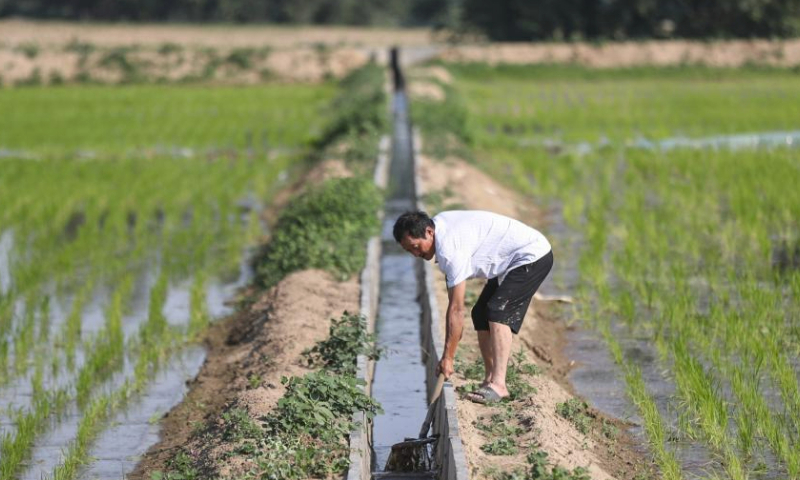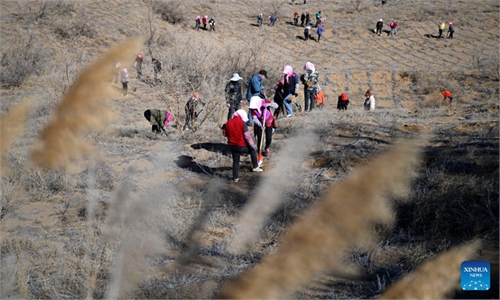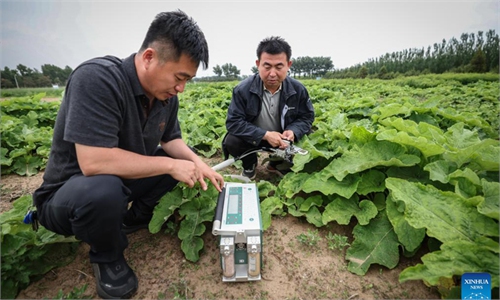
A farmer conducts desilting at a water channel in a rice field in Daleng Town of Zhangwu County, Fuxin City, northeast China's Liaoning Province, June 14, 2023. In 2021, local authorities has promoted the transformation of sandy land along the Liuhe River in Zhangwu into cultivable rice fields, achieving ecological and economic benefit. (Xinhua/Pan Yulong)
China has treated 331 million mu (22 million hectares) of sandy land in just over 10 years, with a closed and protected area of 27.08 million mu, and 53 percent of the reversable sandy land has been effectively treated, the National Forestry and Grassland Administration (NFGA) said on Monday.
As the day marks the world's 30th Desertification and Drought Day and the 30th anniversary of the adoption of the United Nations Convention to Combat Desertification, Chinese Foreign Ministry spokesperson Lin Jian said on Monday that China is the first country in the world to achieve zero net land degradation and reduce both desertification and sandification, making important contribution to meeting the global goal of zero net land degradation by 2030.
According to the release by NFGA, forest and grassland vegetation in key project areas has been effectively restored after a long period of management, and the key management areas have achieved a historic transformation from "sand forcing humans to retreat" to "trees forcing sand to retreat."
The Three-North Shelterbelt Forest Program, a large-scale afforestation project in northwest, north and northeast China, has completed a total of 480 million mu of afforestation, and the treatment of 1.28 billion mu of degraded grassland, with the forest coverage rate increasing from 5.05 percent in 1978 to nearly 14 percent by now.
The situation of sandy land has continued to improve, with a net reduction in the area of sandy land nationwide from an average annual expansion of 5.15 million mu at the end of the last century to a reduction of 10 million mu per year at present, according to the release.
The degree of land desertification has also continued to be reduced, with the proportion of heavy and extremely heavy declining from 74.1 percent in 2004 to 62.3 percent in 2019. Wind and sand hazards have been effectively curbed, with the total amount of soil wind erosion in the eight major deserts and four major sandy areas falling by about 40 percent in 2019 compared with 2000.
An average of 9.2 sand and dust weather processes have occurred annually in the northern region over the past 10 years, showing a trend of decreasing number and weakening intensity compared with an average of 12.5 per year during the same period in the past 30 years, according to the release.
As the ecology of the sandy areas has continued to improve, the farmland protection forest network has effectively protected 450 million mu of farmland, and the sandy areas produce 48 million tons of dried and fresh fruits annually, with a total annual output value of 120 billion yuan ($16 billion).
China fulfilled its obligations under the United Nations Convention to Combat Desertification, deployed and implemented a number of major ecological projects, and promulgated the world's first law to tackle desertification, according to the release.
China's forest coverage ratio and forest stock volume have both increased for 40 consecutive years. It ranks the first country in the world in terms of forest resource growth and afforestation area and has contributed one fourth of the world's newly added green area, Lin said.
Lin added that China is actively forging synergy with the Great Green Wall initiative in Africa and the Middle East Green Initiative through mechanisms including the Forum on China-Africa Cooperation and the China-Arab States Cooperation Forum. The China-Arab International Research Center for Drought, Desertification, and Land Degradation was set up last year and the first batch of cooperation projects have been launched.
The China-Mongolia Desertification Prevention and Control Cooperation Center unveiled in Mongolia last year is now supporting Mongolia in implementing its plan to plant one billion trees. The cooperation between China and other countries in combating desertification has made more countries greener, Lin said.
Lin added that China stands ready to continue to share its experience in combating drought and desertification with all parties, enhance exchanges on sustainable land governance and together make our world a beautiful place enjoying harmony between nature and humanity.
Global Times



